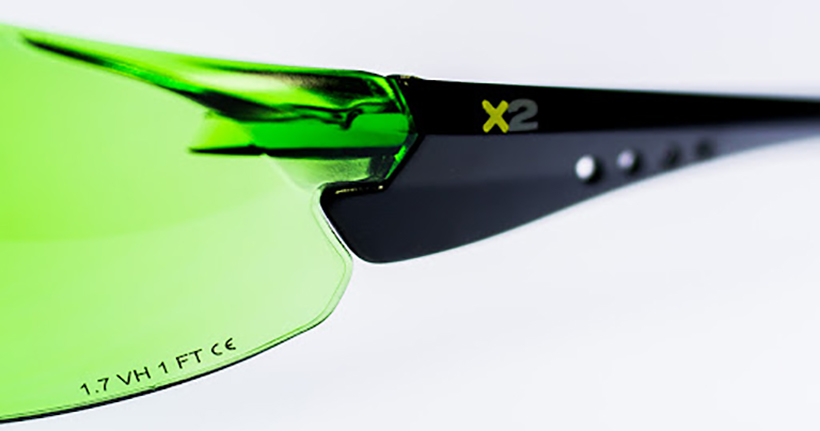- Products
- Services
- Our Story
- Resources
- Innovation Hub
- Sectors
- Sustainability
- Contact Us
For anyone working within a hazardous environment, safety eyewear is one of the most important types of PPE that should be worn. It is vital that workers have high-quality safety eyewear that they can rely on to keep their eyes protected. Whether you require indoor or outdoor protective eyewear, we have a wide range of products to suit your individual needs.
In our recent safety eyewear – ultimate guide blog post we discussed the difference between safety glasses and safety goggles, as well as some of the key features of both. It is important to know that there are lots of different frame markings when it comes to safety eyewear, which you should take into consideration when choosing them. Let’s take a look at these in further detail.
Safety eyewear frame markings are not necessarily that easy to understand at first, but they are designed to provide a clear summary of the standards that each pair of safety glasses meets. They are a quick reference point for employers and employees alike to ensure they are being protected at the right level. The order the markings appear in helps you identify which standard or property is being referred to. The standards are really important as if workers are not given the correct equipment to safely carry out their job, they could be in danger. The frame markings help everyone to understand the capabilities of the particular eyewear, and assess whether it would be suitable for certain roles within the workplace.

Both the frames and the lens are tested, so both should include the CE symbol. The CE marking confirms that the product has met EU standards of consumer health or safety. At the very least, both the lens and the frame should meet BS EN166 standards to be classed as ‘Safety Eyewear’. If you cannot see this standard marked on the eyewear, you should look for an alternative supplier.
So now we have explained the most basic level of frame marking, let’s have a look at some of the other categories. Firstly, we have the field of use which is marked as follows:
3 – this offers protection against liquid droplets and splashes, and are commonly found on safety goggles where there is a full seal around the eyes.
4 – this offers protection against large dust particles that are over 5 microns in size.
5 – this offers protection against dust and finer particles which are smaller than 5 microns.
9 – this classification of safety eyewear are resistant to the penetration of hot solids.
We touched on optical class on our safety eyewear guide, but let’s go into a little more detail on this now. The optical class refers to the clarity of the lens, and is sometimes referred to as optical clarity. It is an indication of the quality of the lens, and duration and length for which the glasses can be safely worn. The number will be marked on the lens, and will be listed as one of the following:
Class 1: this safety eyewear will give the best optical clarity, with no distortion. They are therefore suitable for wearing continuously without harming the eyes.
Class 2: these have a lower optical clarity and are suitable for occasional wear.
Class 3: these are the lowest optical clarity and are suitable only for exceptional use, and should not be worn for any prolonged period of time.
The next two types of frame marking are measures of mechanical strength and optional requirements (which as the term suggests, are not always marked on the frame). Mechanical strength refers to the level of impact the glasses can withstand, and also includes a test for impact at extreme temperatures. Here are the different types of mechanical strength markings:
S: increased robustness, 12 metres per second small object impact rating.
F: low energy impact, 45 metres per second small object impact rating.
B: medium energy impact, 120 metres per second small object impact rating.
A: high energy impact, 190 metres per second small object impact rating.
T: protects from high-speed particles at extreme temperatures.
The optional requirements relate to additional coatings that can be applied to the lens of the Eyewear, improving their performance.
K: resistant to surface damage by fine particles – aka. ‘Anti-scratch’
N: resistant to lens fogging – aka. ‘Anti-fog’ or ‘Anti-mist’
If the above K and N markings appear on Safety Eyewear, it confirms that the Anti-Scratch and Anti-Mist coatings are high quality. However, the Eyewear can still be fully certified to EN166 without them.
Again, radiation protection is usually found in the form of numbers:
2: UV Protection (EN170) coloured filter
2C or 3: UV Protection (EN170) with a clear filter. The ‘C’ indicates the filter allows good colour recognition
4: Infrared filters (EN171)
5: Sun glare protection (EN172)
6: Sun glare with IR filter (EN172 + EN171)
Finally, we have the light transmission figures:
1.2 – allows between 74.4% and 100% of light to pass through
1.7 – allows between 43.2% and 58.1% of light to pass through
2.5 – allows between 17.8% and 29.1% of light to pass through
3.1 – allows between 8% and 17.8% of light to pass through
So there you have it, all of the safety eyewear frame markings clearly explained. If you would like any further help with choosing the right safety eyewear for your needs, contact the expert team at Betafit today who will be more than happy to assist you.